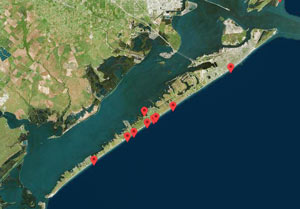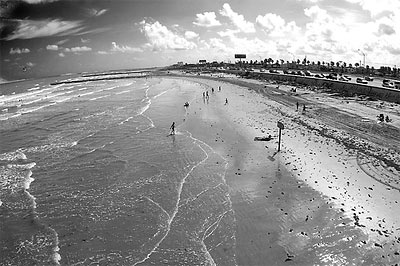EXCESSIVE GALVESTON BEACH BACTERIA PROBABLY NOT LEG-THREATENING, JUST FECAL, SAY OFFICIALS  Scott Packard assures KHOU this week that the beach advisories put out by the Galveston County Health District lately aren’t related to flesh-eating strains of Vibrio bacteria — the agency has been fielding concerned phone calls in the wake of a Jacinto City man’s ongoing hospitalization and forced amputation due to a suspected Vibrio infection following a swim in Galveston with an open wound. But direct infection from seawater contact, while a perennial occurrence in Gulf Coast states, is nonetheless extraordinarily rare, Packard says. Rather, the beach advisories reflect above-standard measuremens of run-of-the-mill fecal bacteria: “Typically after periods of heavy rains [in] any recreational or coastal area, rain water will wash cattle waste, pet waste and some sewage overflows into the Gulf through rivers and streams, and that will make the levels spike for typically a day or so.” [KHOU; previously on Swamplot] Galveston Island sites with high bacteria levels: Texas General Land Office
Scott Packard assures KHOU this week that the beach advisories put out by the Galveston County Health District lately aren’t related to flesh-eating strains of Vibrio bacteria — the agency has been fielding concerned phone calls in the wake of a Jacinto City man’s ongoing hospitalization and forced amputation due to a suspected Vibrio infection following a swim in Galveston with an open wound. But direct infection from seawater contact, while a perennial occurrence in Gulf Coast states, is nonetheless extraordinarily rare, Packard says. Rather, the beach advisories reflect above-standard measuremens of run-of-the-mill fecal bacteria: “Typically after periods of heavy rains [in] any recreational or coastal area, rain water will wash cattle waste, pet waste and some sewage overflows into the Gulf through rivers and streams, and that will make the levels spike for typically a day or so.” [KHOU; previously on Swamplot] Galveston Island sites with high bacteria levels: Texas General Land Office
Tag: Galveston-Beaches
COMMENT OF THE DAY: IN THE CLEAR WATERS OF THE GULF “I take my kids there every couple of weeks all summer and we are in and out of the water all day. I don’t know what it used to be like in the 80s but when we go to Stewart beach now the water is clear, we see dolphins almost every visit and fish literally swim between your toes periodically. I didn’t go down there for a couple of years after moving out here because of the horror stories I heard. They were nonsense then and they’re still nonsense now.” [Jimbo, commenting on Galveston’s Flagship Hotel Fades into the Sunset, Leaves a Few Big Chunks in the Gulf]

Phew! It’s okay to get back in the water at Galveston beaches. Those high levels of Enterococcus bacteria reported on Wednesday, indicating high levels of fecal matter, are gone. Everything’s back to normal!
Where does all that shit come from, anyway? Sewage treatment plants, septic tanks, boating waste, and storm water runoff, among other sources. Says the Texas General Land Office:
Water contact should be avoided for 48 hours following periods of heavy, prolonged rainfall.
Thanks for the tip, guys! You can track bacteria levels daily with a handy interactive map tool at the Texas General Land Office’s Beach Watch website. (Their happy slogan: “Check the Net Before You Get Wet!”) Other bacteria to watch out for: various species of Vibrio, which cause a few deaths a year. But don’t worry—you won’t need to check the net for Vibrio levels, because they aren’t monitored at all.
- Beachgoers return as bacteria levels recede [Houston Chronicle]
- Eeeewwwww! [Houstonist]
- The Texas Beach Watch Program [General Land Office]
Photo: flickr user rodlkennedy

